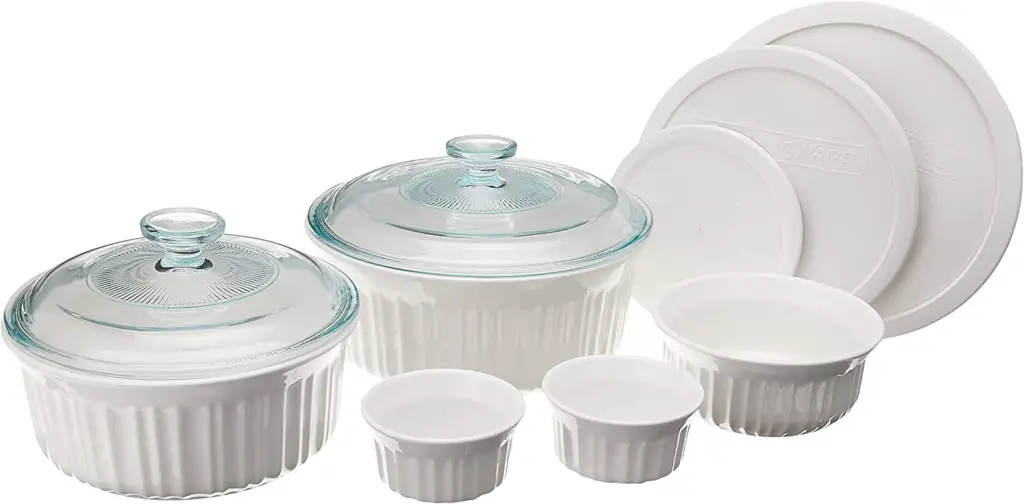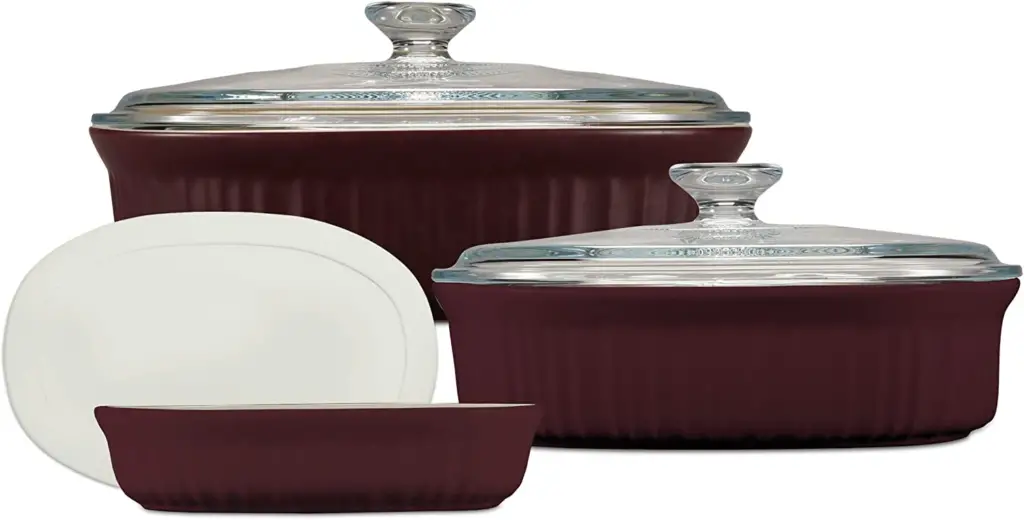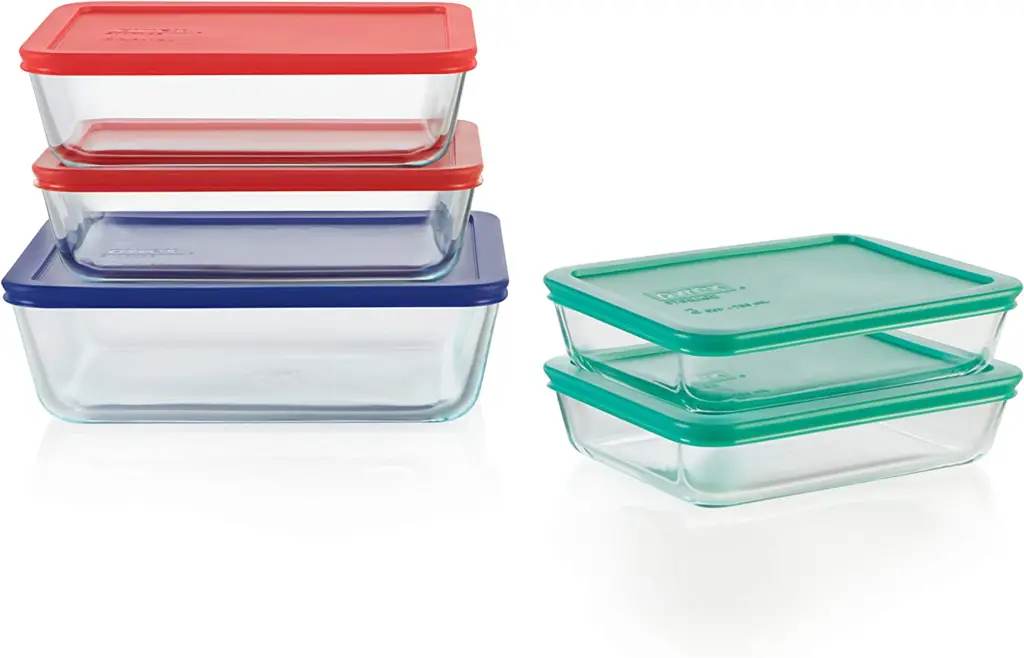Have you ever wondered if you can put CorningWare in a toaster oven while preparing a delightful dish? I’ve pondered this question myself after having a bad experience with a dish before so I had to conduct some extensive research and the results are in!
Yes, you absolutely can put certain types of CorningWare in a toaster oven, but it’s essential to consider the material composition and temperature limits. For instance, Pyroceram CorningWare can withstand high temperatures up to 850°F and is safe for toaster oven use. However, you should avoid using stoneware and glass-ceramic CorningWare in a toaster oven as they are prone to thermal shock. Always consult the manufacturer’s guidelines before using any cookware in a toaster oven and make necessary adjustments to cooking times.
In this article, we will explore the compatibility of CorningWare with toaster ovens, delve into the different types of CorningWare materials, and provide essential kitchen safety tips to ensure you have a pleasant and hazard-free cooking experience.
What is CorningWare?
CorningWare is a versatile and durable cookware brand cherished by many home cooks and professional chefs alike. Let’s dive deeper into its history, composition, and popular products.
- Brief history of CorningWare: CorningWare was introduced in 1958 by Corning Glass Works as a revolutionary new cookware material called Pyroceram, a glass-ceramic substance that could withstand extreme temperature changes without breaking. Its combination of aesthetics and functionality made it an instant success, transforming the way we cook and serve food.
- Composition and materials: Over the years, CorningWare has expanded its product line to include various materials, such as the original Pyroceram, stoneware, and glass-ceramic. Pyroceram is known for its excellent thermal resistance, while stoneware is prized for its heat retention and even cooking properties. Glass-ceramic, on the other hand, offers a blend of glass-like transparency and ceramic strength.
- Popular CorningWare products: Some of the most popular CorningWare products include the classic white casserole dishes with blue cornflower designs, versatile bakeware sets, and contemporary stoneware pieces. These products are designed to go from oven to table seamlessly, making them a staple in many kitchens worldwide.

Understanding Toaster Ovens
As someone who never used to read appliance manuals, I’ve learned the hard way how important it is to understand your toaster oven. Let’s explore the different types, temperature ranges, and key features of this versatile kitchen appliance.
Types of toaster ovens
Toaster ovens come in various types, each offering different features and capabilities. Below are a few of the most common types:
- Standard Toaster Oven: This is your basic model, suitable for toasting bread, reheating leftovers, and baking small items. They often have bake, broil, and toast settings, making them a versatile addition to any kitchen.
- Convection Toaster Oven: These ovens circulate hot air using a fan, ensuring even heating and faster cooking times. They’re perfect for baking cookies, roasting vegetables, or cooking any recipe that requires consistent heat.
- Infrared Toaster Oven: These use light energy to quickly and efficiently cook food. They don’t require preheating and can cook food faster than standard or convection toaster ovens.
- Rotisserie Toaster Oven: As the name suggests, these toaster ovens come with a rotisserie spit, which is great for roasting whole chickens or other meats evenly and to perfection.
- Combination Toaster Oven: These versatile appliances are a combination of a standard toaster with slots on the top and a toaster oven. This type is perfect for those who want the best of both worlds but have limited counter space.
Remember, the type of toaster oven that’s best for you depends on your cooking needs and the amount of counter space you have available.
Temperature ranges
Toaster ovens typically have a temperature range of around 150°F to 500°F, making them suitable for a wide array of cooking tasks. Some advanced models may offer even higher maximum temperatures or precision temperature control for optimal cooking results.
7 Key features and advantages
- Space-saving: Toaster ovens are compact, making them ideal for small kitchens or limited countertop space.
- Energy efficiency: These appliances generally use less energy than traditional ovens, saving you money on electricity bills.
- Speed: They heat up faster than conventional ovens, reducing preheating time and overall cooking duration.
- Versatility: Toaster ovens can toast, bake, broil, and even air fry, depending on the model and features.
- Precision: Many toaster ovens come with adjustable temperature controls and timers, allowing you to fine-tune your cooking for perfect results.
- Easy cleaning: With removable crumb trays and non-stick interiors, toaster ovens are generally easy to clean and maintain.
- Convenience: Their compact size and cooking versatility make toaster ovens perfect for preparing quick meals, snacks, or side dishes without using a full-sized oven.
Compatibility of CorningWare and Toaster Ovens
After making a few calls to expert technicians from Best Buy and Walmart, I can confidently say that not all CorningWare is created equal when it comes to toaster oven compatibility. Here were my findings:
Temperature limits of CorningWare materials:
- Pyroceram: Highly resistant to thermal shock, it can handle temperatures up to 850°F, making it safe for toaster oven use.
- Stoneware: While it can withstand high temperatures, it may be prone to thermal shock, making it less suitable for toaster ovens.
- Glass-ceramic: Although it offers some thermal resistance, it may crack under sudden temperature changes, so it’s best to avoid using it in toaster ovens.
How to safely use CorningWare in a toaster oven:
- Only use Pyroceram CorningWare, as it is the most heat resistant.
- Ensure your dish fits correctly inside the toaster oven.
- Adjust cooking times as needed, as toaster ovens typically cook faster than traditional ovens.
- Always use oven mitts when handling hot CorningWare to avoid burns.
Pyroceram
Pyroceram, the original CorningWare material, is a glass-ceramic substance known for its outstanding thermal resistance. It is designed to withstand sudden temperature changes without cracking or breaking, making it ideal for various cooking applications, including toaster oven use.
Stoneware
Stoneware is a type of ceramic cookware that is cherished for its heat retention and even cooking properties. Although it can handle high temperatures, it is less resistant to thermal shock compared to Pyroceram. As a result, it’s generally not recommended for use in toaster ovens.
Glass-ceramic
Glass-ceramic is a material that offers a unique combination of glass-like transparency and ceramic strength. While it has some resistance to temperature changes, it is still prone to thermal shock, making it unsuitable for use in toaster ovens where rapid temperature changes can occur.

Size and shape considerations:
Size and shape considerations are essential factors to keep in mind when using CorningWare or any other cookware in a toaster oven. To ensure a safe and efficient cooking experience, follow these guidelines:
- Check the dimensions: Measure your CorningWare dish, including any handles or protrusions, and compare it with the interior dimensions of your toaster oven. Ensure that the dish can fit comfortably inside without touching the heating elements, oven walls, or door.
- Allow for proper airflow: When placing your CorningWare dish in the toaster oven, make sure there is enough space for airflow around it. Proper air circulation is crucial for even cooking and preventing any potential hotspots or overheating.
- Use appropriate dish shapes: Choose a dish shape that suits the specific toaster oven setting you plan to use. For example, when using the broil setting, opt for a shallow dish that allows for more direct exposure to the heating element. When baking, a deeper dish might be more appropriate.
- Match the dish size to the meal: Use appropriately sized CorningWare dishes for the quantity of food you are cooking. Overcrowding a dish or using one that is too large for the amount of food can result in uneven cooking.
- Consider oven rack placement: Adjust the oven rack height based on the size and shape of your CorningWare dish. This will ensure the dish is positioned at the optimal distance from the heating elements for even cooking.
By taking size and shape considerations into account when using CorningWare in a toaster oven, you can maximize the appliance’s capabilities while maintaining safety and achieving the best cooking results.
Alternatives to CorningWare for Toaster Ovens
While CorningWare is an excellent choice for many cooking tasks, there are other options to consider when it comes to toaster oven-safe cookware. Let’s compare some of them:
| Cookware | Pros | Cons |
|---|---|---|
| Pyrex | Resistant to thermal shock, affordable, transparent for easy monitoring | Not suitable for broiling or use under a grill, avoid sudden temperature changes |
| Cast Iron | Excellent heat retention, versatile (can be used on stovetop, in oven, or under a broiler), durable | Heavy, requires special care to prevent rusting, may scratch glass or ceramic surfaces |
| Ceramic Cookware | Even heat distribution, nonreactive with food, aesthetic appeal | Potential for cracking under extreme temperature changes, may not be suitable for high heat settings |
| Stainless Steel | Durable, resistant to rust and staining, suitable for high temperatures | Not great at heat distribution unless it has an aluminum or copper core, can be pricey |
| Silicone Bakeware | Lightweight, easy to clean, non-stick without the use of chemicals | May not hold up well under broiler, can be flimsy and hard to handle when filled |

Kitchen Safety Tips When Using Toaster Ovens
Toaster ovens might be small, but boy, do they pack a punch! Let’s go over some safety tips to ensure we’re using these powerhouses correctly and safely.
- Proper appliance usage: Always read and follow the manufacturer’s instructions. This isn’t just something we say to sound important, folks. This is about your safety and the longevity of your beloved toaster oven.
- Cookware guidelines: Use cookware that’s toaster oven-safe (like our good friend Pyroceram CorningWare). Don’t just assume that anything that can go in the big oven can go in the toaster oven. That’s a rookie mistake.
- Cooking precautions: Keep an eye on your food while it’s cooking to prevent any unwanted “flavor” (AKA charring). Also, always use oven mitts when handling hot cookware. We want to savor our food, not our fingers!
- Oven care and maintenance: Regularly clean your toaster oven according to the manufacturer’s instructions to prevent buildup of food particles and grease, which could potentially cause a fire. Let’s keep the fireworks to the 4th of July, shall we?
Frequently Asked Questions (FAQ)
Let’s answer a few burning questions that I get from readers just like you:
- Can I use aluminum foil in a toaster oven? Yes, but proceed with caution! While it’s generally safe to use aluminum foil in a toaster oven, you should avoid letting it come into contact with the heating elements or walls. Never cover the crumb tray entirely as it can cause heat buildup and possibly a fire.
- Is parchment paper safe for toaster oven use? Parchment paper can be a handy partner in a toaster oven, but keep it away from the heating elements, and never use it at temperatures higher than the paper’s recommended limit (usually around 450°F).
- How do I adjust cooking times for a toaster oven? Generally, toaster ovens cook faster than conventional ovens due to their smaller size. As a rule of thumb, reduce cooking time by about 25% and check your food often until you get the hang of it.
- Can I use cast iron cookware in a toaster oven? Yes, cast iron cookware can be used in a toaster oven, as long as it fits! Remember, cast iron retains heat incredibly well, so always use oven mitts when handling it.
Final Thoughts
Well folks, we’ve reached the end of our culinary journey today. We’ve confirmed that certain CorningWare products are safe for toaster oven use, with Pyroceram leading the pack. Remember, the size and shape of your CorningWare matter, too. And let’s not forget about the alternatives – Pyrex, cast iron, ceramic, stainless steel, and silicone bakeware all have their roles to play in the toaster oven game.
Don’t forget those safety tips, either. A properly used and well-maintained toaster oven is a happy toaster oven. And let’s be real – nobody likes a grumpy appliance.
So now, armed with your newfound knowledge, it’s time for you to go forth, explore, and maybe even push the culinary boundaries. After all, isn’t that why we’re all here? To make the most of our cooking adventures. Happy cooking!

